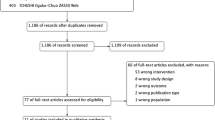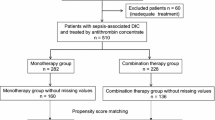Abstract
Background
Disseminated Intravascular Coagulation (DIC) is a syndrome of dysregulated coagulation. Patients with sepsis are at increased risk for DIC. HMG-CoA Reductase Inhibitors (Statins) are primarily used as lipid-lowering agents; however, studies have suggested statins may possess anti-inflammatory, antithrombotic, anticoagulant, and endothelial stabilizing properties. These mechanisms may oppose those that underlie the pathogenesis of septic DIC.
Methods
To evaluate whether statins may be protective against the development of DIC, we conducted a multi-center, retrospective case-control study where 86,638 critically ill patients admitted to the ICU with sepsis, severe sepsis or septic shock were identified during a 3-year period. Patients who developed DIC during their hospitalization were identified and stratified by whether they received a statin or not during their hospitalization. Odds ratios for development of DIC was calculated by composite of any statin, as well as low, moderate, and high intensity statins.
Results
2236 patients would develop DIC compared to 84,402 who did not. The use of any statin was associated with a reduced likelihood for developing DIC (odds ratio [OR], 0.69; 95% CI, 0.61–0.78). This was observed with use of both moderate (OR, 0.64; 95% CI, 0.53–0.77) and high (OR, 0.72; 95% CI, 0.61–0.84) but not low intensity statins (OR, 0.84; 95% CI, 0.53–1.32).
Conclusions
The use of moderate and high intensity statins was associated with a significantly reduced odds of developing DIC in critically ill patients with sepsis. This present study may be the first to suggest that statin medications may independently reduce the frequency of DIC in critically ill patients with severe sepsis or septic shock. More research is needed to investigate the potential for this class of medication to be protective against DIC.


Similar content being viewed by others
References
Gando S, Shiraishi A, Yamakawa K et al (2019) Japanese Association for Acute Medicine [JAAM) focused Outcomes Research in Emergency Care in Acute Respiratory Distress Syndrome, Sepsis and Trauma (FORECAST) Study Group. Role of disseminated intravascular coagulation in severe sepsis. Thromb Res 178:182–188. https://doi.org/10.1016/j.thromres.2019.04.025
Levi M, Scully M (2018) How I treat disseminated intravascular coagulation. Blood 131:845–854. https://doi.org/10.1182/blood-2017-10-804096
Iba T, Watanabe E, Umemura Y, Wada T, Hayashida K, Kushimoto S (2019) Japanese surviving Sepsis Campaign Guideline Working Group for disseminated intravascular coagulation. Sepsis-associated disseminated intravascular coagulation and its differential diagnoses. J Intensive Care 7:32. https://doi.org/10.1002/ams2.411
Okamoto K, Tamura T, Sawatsubashi Y (2016) Sepsis and disseminated intravascular coagulation. J Intensive Care 23:4–23. https://doi.org/10.1186/s40560-016-0149-0
Cohen J (2002) The immunopathogenesis of sepsis. Nature. https://doi.org/10.1038/nature01326. 420:885 – 91
Liao JK, Laufs U (2005) Pleiotropic effects of statins. Annu Rev Pharmacol Toxicol 45:89–118. https://doi.org/10.1146/annurev.pharmtox.45.120403.095748
Diamantis E, Kyriakos G, Quiles-Sanchez LV, Farmaki P, Troupis T (2017) The anti-inflammatory effects of statins on Coronary Artery Disease: an updated review of the literature. Curr Cardiol Rev 13:209–216. https://doi.org/10.2174/1573403X13666170426104611
Bakhtiari K, Meijers JC, de Jonge E, Levi M (2004) Prospective validation of the International Society of Thrombosis and Haemostasis scoring system for disseminated intravascular coagulation. Crit Care Med 32:2416–2421. https://doi.org/10.1097/01.ccm.0000147769.07699.e3
Singer M, Deutschman CS, Seymour CW et al (2016) The Third International Consensus definitions for Sepsis and septic shock (Sepsis-3). JAMA 315:801. https://doi.org/10.1001/jama.2016.0287
Sidebottom AC, Vacquier MC, Jensen JC et al (2020) Trends in prevalence of guideline-based use of lipid-lowering therapy in a large health system. Clin Cardiol 43(6):560–567. https://doi.org/10.1002/clc.23347
Roy AM, Konda M, Goel A, Sasapu A (2019) Epidemiology and factors affecting mortality of hospitalized patients with disseminated intravascular coagulation in the United States. Blood 134:2404. https://doi.org/10.1182/blood-2019-132071
Falanga A, Marchetti M, Vignoli A (2013) Coagulation and cancer: biological and clinical aspects. J Thromb Haemost 11:223–233. https://doi.org/10.1111/jth.12075
Seymour CW, Liu VX, Iwashyna TJ, Brunkhorst FM, Rea TD, Scherag A, Rubenfeld G, Kahn JM, Shankar-Hari M, Singer M, Deutschman CS, Escobar GJ, Angus DC (2013) Assessment of Clinical Criteria for Sepsis: for the Third International Consensus definitions for Sepsis and septic shock (Sepsis-3). JAMA 315:762–774. https://doi.org/10.1001/jama.2016.0288
Yamazaki M, Aoshima K, Mizutani T, Ontachi Y, Saito M, Morishita E, Asakura H, Matsuda T, Triplett DA (1999) Prednisolone inhibits endotoxin-induced disseminated intravascular coagulation and improves mortality in rats: importance of inflammatory cytokine suppression. Blood Coagul Fibrinolysis 10:321–330. https://doi.org/10.1097/00001721-199909000-00002
Liu XL, Wang XZ, Liu XX, Hao D, Jaladat Y, Lu F, Sun T, Lv CJ (2014) Low-dose heparin as treatment for early disseminated intravascular coagulation during sepsis: a prospective clinical study. Exp Ther Med 7:604–608. https://doi.org/10.3892/etm.2013.1466
Sakuragawa N, Hasegawa H, Maki M, Nakagawa M, Nakashima M (1993) Clinical evaluation of low-molecular-weight heparin (FR-860) on disseminated intravascular coagulation (DIC)--a multicenter co-operative double-blind trial in comparison with heparin. Thromb Res 72:475–500. https://doi.org/10.1016/0049-3848(93)90109-2
Papageorgiou C, Jourdi G, Adjambri E, Walborn A, Patel P, Fareed J, Elalamy I, Hoppensteadt D, Gerotziafas GT (2018) Disseminated intravascular coagulation: an update on Pathogenesis, diagnosis, and therapeutic strategies. Clin Appl Thromb Hemost 24:8S28S. https://doi.org/10.1177/1076029618806424
Jain MK, Ridker PM (2005) Anti-inflammatory effects of statins: clinical evidence and basic mechanisms. Nat Rev Drug Discov. https://doi.org/10.1038/nrd1901. 4:977 – 87
Undas A, Brummel-Ziedins KE, Mann KG (2005) Statins and blood coagulation. Arterioscler Thromb Vasc Biol. https://doi.org/10.1161/01.ATV.0000151647.14923.ec. 25:287 – 94
Greenwood J, Mason JC (2007) Statins and the vascular endothelial inflammatory response. Trends Immunol 28:88–98. https://doi.org/10.1016/j.it.2006.12.003
Badimon L, Vilahur G (2014) Thrombosis formation on atherosclerotic lesions and plaque rupture. J Intern Med 276:618–632. https://doi.org/10.1111/joim.12296
Diomede L, Albani D, Sottocorno M, Donati MB, Bianchi M, Fruscella P, Salmona M (2001) In vivo anti-inflammatory effect of statins is mediated by nonsterol mevalonate products. Arterioscler Thromb Vasc Biol 21:1327–1332. https://doi.org/10.1161/hq0801.094222
Sukhova GK, Williams JK, Libby P (2002) Statins reduce inflammation in atheroma of nonhuman primates Independent of effects on serum cholesterol. Arterioscler Thromb Vasc Biol 22:1452–1458. https://doi.org/10.1161/01.atv.0000030360.72503.56
Monetti M, Canavesi M, Camera M, Parente R, Paoletti R, Tremoli E, Corsini A, Bellosta S (2007) Rosuvastatin displays anti-atherothrombotic and anti-inflammatory properties in apoe-deficient mice. Pharmacol Res 55:441–449. https://doi.org/10.1016/j.phrs.2007.02.001
Yoshida M, Sawada T, Ishii H, Gerszten RE, Rosenzweig A, Gimbrone MA Jr, Yasukochi Y, Numano F (2001) Hmg-CoA reductase inhibitor modulates monocyte-endothelial cell interaction under physiological flow conditions in vitro: involvement of rho GTPase-dependent mechanism. Arterioscler Thromb Vasc Biol 21:1165–1171. https://doi.org/10.1161/hq0701.092143
Colli S, Eligini S, Lalli M, Camera M, Paoletti R, Tremoli E (1997) Vastatins inhibit tissue factor in cultured human macrophages. A novel mechanism of protection against atherothrombosis. Arterioscler Thromb Vasc Biol 17:265–272. https://doi.org/10.1161/01.atv.17.2.265
Baetta R, Camera M, Comparato C, Altana C, Ezekowitz MD, Tremoli E (2002) Fluvastatin reduces tissue factor expression and macrophage accumulation in carotid lesions of cholesterol-fed rabbits in the absence of lipid lowering. Arterioscler Thromb Vasc Biol 22:692–698. https://doi.org/10.1161/01.atv.0000012802.69414.a8
Lopez S, Peiretti F, Bonardo B, Deprez-Beauclair P, Laouenan H, Juhan-Vague I, Nalbone G (2001) Effect of atorvastatin on plasminogen activator inhibitor type-1 synthesis in human monocytes/macrophages. J Cardiovasc Pharmacol 37:762–768. https://doi.org/10.1097/00005344-200106000-00014
Bourcier T, Libby P (2000) HMG CoA reductase inhibitors reduce plasminogen activator inhibitor-1 expression by human vascular smooth muscle and endothelial cells. Arterioscler Thromb Vasc Biol 20:556–562. https://doi.org/10.1161/01.atv.20.2.556
Guven GS, Atalar E, Yavuz B, Beyazit Y, Kekilli M, Kilicarslan A, Sahiner L, Oz G, Ozer N, Aksoyek S, Haznedaroglu IC, Sozen T (2006) Simvastatin treatment improves endothelial function and increases fibrinolysis in patients with hypercholestrolemia. J Natl Med Assoc 98:627–630
Bruni F, Pasqui AL, Pastorelli M, Bova G, Di Renzo M, Cercigani M, Leo A, Auteri A, Puccetti L (2004) Effect of atorvastatin on different fibrinolyis mechanisms in hypercholesterolemic subjects. Int J Cardiol 95:269–274. https://doi.org/10.1016/j.ijcard.2003.08.003
Shi J, Wang J, Zheng H, Ling W, Joseph J, Li D, Mehta JL, Ponnappan U, Lin P, Fink LM, Hauer-Jensen M (2003) Statins increase thrombomodulin expression and function in human endothelial cells by a nitric oxide-dependent mechanism and counteract Tumor necrosis factor alpha-induced thrombomodulin downregulation. Blood Coagul Fibrinolysis 14:575–585. https://doi.org/10.1097/00001721-200309000-00010
Masamura K, Oida K, Kanehara H, Suzuki J, Horie S, Ishii H, Miyamori I (2003) Pitavastatin-induced thrombomodulin expression by endothelial cells acts via inhibition of small G proteins of the rho family. Arterioscler Thromb Vasc Biol 23:512–517. https://doi.org/10.1161/01.ATV.0000060461.64771.F0
Obi C, Wysokinski W, Karnicki K, Owen WG, McBane RD (2009) Inhibition of platelet-rich arterial thrombus in vivo: acute antithrombotic effect of intravenous HMG-CoA reductase therapy. Arterioscler Thromb Vasc Biol 29:1271–1276. https://doi.org/10.1161/ATVBAHA.109.190884
Matetzky S, Fefer P, Shenkman B, Shechter M, Novikov I, Savion N, Varon D, Hod H (2011) Statins have an early antiplatelet effect in patients with acute Myocardial Infarction. Platelets 22:103–110. https://doi.org/10.3109/09537104.2010.512402
Laufs U, La Fata V, Plutzky J, Liao JK (1998) Upregulation of endothelial nitric oxide synthase by HMG CoA reductase inhibitors. Circulation 97:1129–1135. https://doi.org/10.1161/01.cir.97.12.1129
Wassmann S, Laufs U, Bäumer AT, Müller K, Ahlbory K, Linz W, Itter G, Rösen R, Böhm M, Nickenig G (2001) HMG-CoA reductase inhibitors improve endothelial dysfunction in normocholesterolemic Hypertension via reduced production of reactive oxygen species. Hypertension 37:1450–1457. https://doi.org/10.1161/01.hyp.37.6.1450
Matsuda T (1996) Clinical aspects of DIC–disseminated intravascular coagulation. Pol J Pharmacol 48:73–75
Lyons PG, Micek ST, Hampton N, Kollef MH (2018) Sepsis-associated coagulopathy severity predicts hospital mortality. Crit Care Med 46:736–742. https://doi.org/10.1097/CCM.0000000000002997
Solanki D, Lal D, Sunny A, Han X, Iyanar S, Halder A, Mullangi S, Desai M, Khan U, Theli A, Devani H, Kumar P, Patel AA, Lekkala M (2022) Temporal trends, predictors, and outcomes of disseminated intravascular coagulation in Hospitalizations with Sepsis. Cureus 14:e27477. https://doi.org/10.7759/cureus.27477
Alhazzani W, Lim W, Jaeschke RZ, Murad MH, Cade J, Cook DJ (2013) Heparin thromboprophylaxis in medical-surgical critically ill patients: a systematic review and meta-analysis of randomized trials. Crit Care Med 41:2088–2098. https://doi.org/10.1097/CCM.0b013e31828cf104
Tang N, Bai H, Chen X, Gong J, Li D, Sun Z (2019) Anticoagulant treatment is associated with decreased mortality in severe coronavirus Disease 2019 patients with coagulopathy. J Thromb Haemost 18(5):1094–1099. https://doi.org/10.1111/jth.14817
Asakura H, Ogawa H COVID-19-associated coagulopathy and disseminated intravascular coagulation. Int J Hematol 113:45–57. https://doi.org/10.1007/s12185-020-03029-y
Zarychanski R, Abou-Setta AM, Kanji S, Turgeon AF, Kumar A, Houston DS, Rimmer E, Houston BL, McIntyre L, Fox-Robichaud AE, Hébert P, Cook DJ, Fergusson DA, Canadian Critical Care Trials Group (2015) The efficacy and safety of heparin in patients with sepsis: a systematic review and metaanalysis. Crit Care Med 43:511–518. https://doi.org/10.1097/CCM.0000000000000763
Fan Y, Jiang M, Gong D, Zou C (2016) Efficacy and safety of low-molecular-weight heparin in patients with sepsis: a meta-analysis of randomized controlled trials. Sci Rep 6:25984. https://doi.org/10.1038/srep25984
Lippi G, Langer F, Favaloro EJ (2020) Direct oral anticoagulants for disseminated intravascular coagulation: an alliterative wordplay or potentially Valuable Therapeutic interventions? Semin Thromb Hemost 46:457–464. https://doi.org/10.1055/s-0039-3402478
Liang H, Song H, Zhai R, Song G, Li H, Ding X, Kan Q, Sun T (2021) Corticosteroids for treating Sepsis in adult patients: a systematic review and Meta-analysis. Front Immunol 12:709155. https://doi.org/10.3389/fimmu.2021.709155
Nanna MG, Navar AM, Zakroysky P et al (2018) Association of Patient Perceptions of Cardiovascular Risk and beliefs on statin Drugs with racial differences in statin use: insights from the patient and Provider Assessment of lipid Management Registry. JAMA Cardiol 3:739–748. https://doi.org/10.1001/jamacardio.2018
Acknowledgements
We would like to thank Jacob Clute for his assistance with statistical analysis and Marley Morrell, BS, for assistance with graphic design.
Funding
None.
Author information
Authors and Affiliations
Corresponding author
Ethics declarations
Competing interests
All authors have indicated they have no potential conflicts of interest to declare.
Disclosures
This research was supported (in whole or in part) by HCA Healthcare and/or an HCA Healthcare affiliated entity. The views expressed in this publication represent those of the author(s) and do not necessarily represent the official views of HCA Healthcare or any of its affiliated entities.
Additional information
Publisher’s Note
Springer Nature remains neutral with regard to jurisdictional claims in published maps and institutional affiliations.
Electronic supplementary material
Below is the link to the electronic supplementary material.
Rights and permissions
Springer Nature or its licensor (e.g. a society or other partner) holds exclusive rights to this article under a publishing agreement with the author(s) or other rightsholder(s); author self-archiving of the accepted manuscript version of this article is solely governed by the terms of such publishing agreement and applicable law.
About this article
Cite this article
Alana, N.B., Ciurylo, W.A. & Hurlock, N. HMG-CoA reductase inhibitors and the attenuation of risk for disseminated intravascular coagulation in patients with sepsis. J Thromb Thrombolysis 57, 260–268 (2024). https://doi.org/10.1007/s11239-023-02910-x
Accepted:
Published:
Issue Date:
DOI: https://doi.org/10.1007/s11239-023-02910-x




